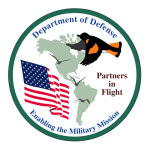The Department of Defense (DoD) Partners in Flight (PIF) program supports and enhances the military mission by providing a focused and coordinated approach for the conservation of migratory and resident birds and their habitats on DoD lands. DoD PIF provides a scientific basis for maximizing the effectiveness of resource management, enhancing the biological integrity of DoD lands, and ensuring continued use of these lands to fulfill military training requirements. The key components to DoD PIF’s work are its partnerships at local, state, regional, national, and international levels, as well as its leadership in implementing ecosystem-based bird conservation planning, installation, and regional Integrated Management Plans (INRMPs), the DoD Coordinated Bird Monitoring Plan, North American Bird Conservation Initiative (NABCI) projects, management of DoD’s Important Bird Areas Program, and the Bird/Animal Aircraft Strike Hazard (BASH) Program.
DoD PIF works beyond installation boundaries to facilitate cooperative partnerships, determine current status of migratory birds and causes of population fluctuations, identify and maintain priority habitats for birds, and proactively manage DoD lands to prevent the listing of additional birds as threatened or endangered. By identifying species of concern and managing habitats for those species, future listings can be minimized or eliminated. Through the PIF species assessment process and the PIF Bird Conservation Planning approach, the integration of bird conservation plans into installation INRMPs is improving the quality and effectiveness of natural resources management on DoD installations. Healthy habitats protect the military mission, help maintain active training lands, and address sustainable range implications.
DoD is an active partner in both the international PIF coalition and NABCI. DoD PIF maintains a dialogue with U.S. Fish & Wildlife Service regarding the status of migratory birds and habitats, and provides installation resource managers with the most current migratory bird information and resources to incorporate into their management planning. DoD PIF also works with sister agencies, state agencies, and other partners to better leverage resources to maximize conservation effectiveness and efficiency.
Interaction at the state, regional, and national levels is critical to maintaining the strength of DoD PIF. The network of DoD PIF representatives meets for an annual planning workshop to evaluate implementation of the DoD PIF Strategic Plan and set priorities for the next year. Large scale priorities, such as a coordinated bird monitoring strategy, habitat and species management, DoD policies and programs, and invasive species, are reviewed in the context of providing continued mission support by maintaining healthy lands and complying with regulations (e.g., National Environmental Policy Act, Executive Order 13186 Memorandum of Understanding, and the Migratory Bird Rule). A DoD PIF meeting held at the annual National Military Fish & Wildlife Association Training Workshop each spring is particularly fruitful for information exchange and planning annual bird conservation priorities for DoD. The DoD PIF network reviews bird-related funding proposals for the Legacy Resource Management Program (see Funding for more information).

